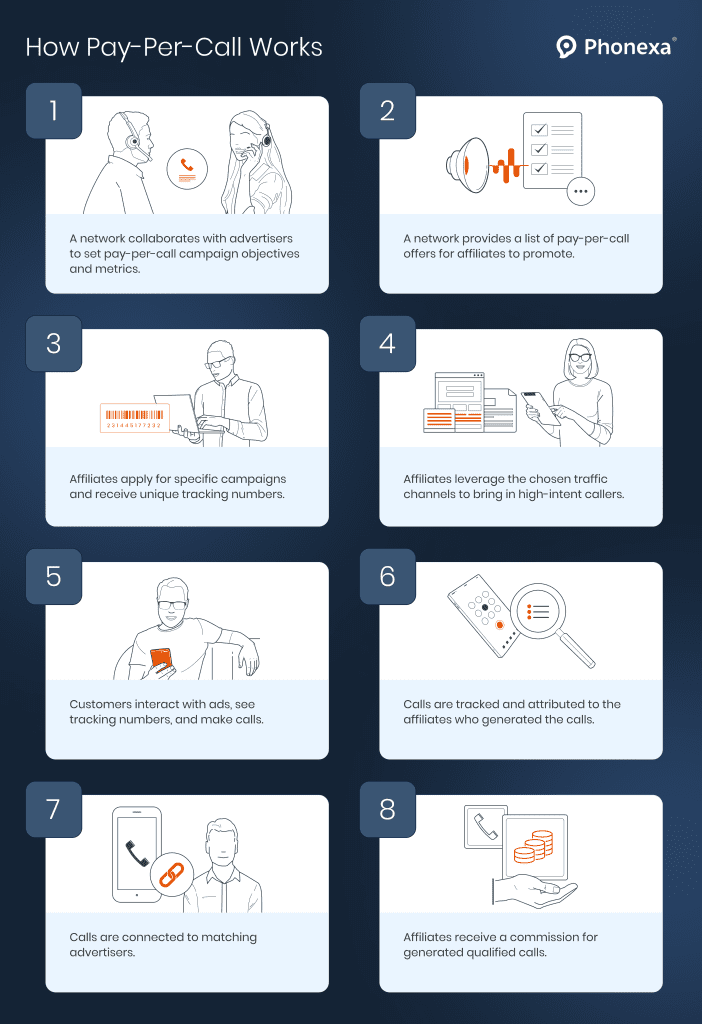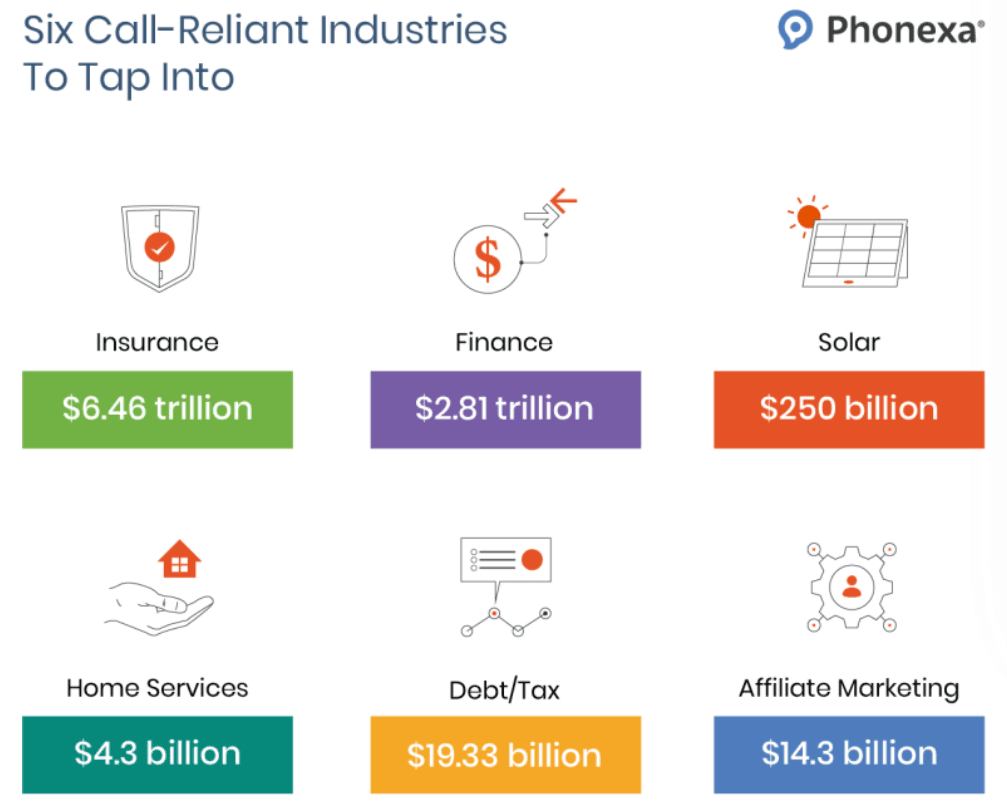Humankind is progressing at a speed not known before. Perhaps the area that is changing the fastest is technology.
To think that less than 100 years ago, our grandparents and parents could enjoy the first TV sets, and now we spend most of our day with mobile phones. Technological evolution impacts most areas of life. Nearly everything changes.
Some 95% of responders call or receive calls to communicate in their work or private life. This is where pay-per-call software steps in and changes how we do business. In this context, pay-per-call affiliate marketing emerges as a vital component, bridging traditional communication with digital marketing strategies by rewarding affiliates for generating quality phone leads. The use of pay-per-call software facilitates this integration, enhancing the efficiency and effectiveness of tracking and analyzing these calls.
Though calls are central to the buying process for many industries like insurance, lending, and healthcare, they can still often present a challenge for companies that need to be used for integrating their voice communication with their digital efforts.
To stay ahead of the curve, advertisers, publishers, networks, and agencies should consider investing in pay-per-call software where inbound calls are tracked and analyzed like every other digital lead.

What Is Pay-Per-Call Marketing?
Pay-per-call marketing describes the relationship between pay-per-call publishers and advertisers and call-based campaigns that generate leads.
It is essential to implement pay-per-call campaigns to build solid inbound marketing strategies, increase sales, and generate more revenue from calling customers. Pay-per-call marketing is a carefully crafted step-by-step phone call campaign that enables prospective customers to see your pay-per-call ads.
Accordingly, pay-per-call leads that reach you using a unique trackable number are your hot leads interested in the products or services you advertise. As a part of performance marketing, you pay pay-per-call publishers or affiliates only for the objectives you achieve.
Connecting publishers to the right pay-per-call affiliate programs can be a great way to drive income, and pay-per-call networks offer exciting opportunities. Pay-per-call marketing is an attractive option for both affiliates and program promoters, with huge potential earnings for each successful lead conversion or customer acquisition.
Phonexa’s Call Logic solution simplifies call management and distribution, enabling marketers to increase their chances of success in selling calls through an expansive network. With the built-in Ping Post Calls 2.0 technology, Call Logic allows both call buyers and sellers to get equally good insights into their campaigns.
The 2021 State of B2B Social Media Marketing study, released by Oktopost, revealed figures indicating that pay-per-call marketing ranked as the third top-growing marketing channel of the last year, next only to social media (82%) and website (67%). It deserves careful consideration since it is already among the top fastest-growing marketing channels.

Source: Oktopost
How Does Pay-Per-Call Marketing Work?
Let’s take a look at a few basic steps that take place during every pay-per-call marketing campaign:
- A company, brand, or advertiser works closely with partners to define their target audience, campaign goals, and the specific metrics to qualify a call as a successful lead. This planning phase is critical as it sets the direction for the entire pay-per-call campaign.
- An advertiser places an order with pay-per-call marketing affiliates, publishers, or performance agencies.
- A publisher creates content for a pay-per-call affiliate offer and sets it up on specific websites targeting prospective customers. This content must resonate with the intended audience and clearly convey the value proposition of the product or service.
- A caller sees an ad, dials a unique pay-per-call tracking number, and gets transferred to the advertiser.
- Each pay-per-call campaign is associated with a unique call tracking number that ties back to its source and certain coding on websites or pay-per-call landing pages that capture key points of what led up to the call – helping to determine if it was a referral, web-based lead, Google advertisement, or keyword search.

Call tracking software companies provide toll-free or vanity numbers that help generate inbound calls because they often seem more legitimate and can even be associated with a particular advertiser’s branding.
For instance, Phonexa’s Call Logic platform helps businesses track incoming calls while providing valuable insights into customer habits that enable marketers to enhance their pay-per-call marketing strategies for maximum efficiency.
In a nutshell, an advertiser is paying a publisher for qualified leads. Depending on the deal, an advertiser can pay per generated call or a commission for a successful sale.
Further, we will highlight why pay-per-call marketing is so popular nowadays and why taking notice is essential.

What Channels Yield the Best Results for Pay-Per-Call Marketing Campaigns?
Pay-per-call campaigns offer an effective way for advertisers and publishers to reach their target audiences through online and traditional marketing tactics. Marketers often see excellent outcomes when using the following channels:
| Paid search | These ads are highly targeted ads that can be optimized for specific keywords, making them effective in reaching potential customers through pay-per-call campaigns. |
| Organic search | Enhancing a website’s organic search presence through search engine optimization (SEO) involves optimizing website content to appear higher in unpaid search engine results. |
| Mobile search | Pay-per-call campaigns optimized for mobile search are designed to capture users’ attention on mobile devices, offering a direct and immediate way for them to connect with advertisers through calls. |
| Social media | Advertisers can use targeted ads on Facebook, Instagram, and LinkedIn to reach specific demographics, interests, and behaviors. |
| Display ads | These ads appear on websites and can include interactive elements to encourage viewers to make a call. |
| Email marketing | Sending targeted emails as part of your pay-per-call marketing campaigns to a curated list of recipients can prompt direct responses. |
| Video ads | This type of ad can include a call-to-action for viewers to dial a number for more information or to take advantage of an offer. |
| Retargeting | This technique involves targeting users who have previously interacted with your brand or visited your website. Retargeting ads remind these users of your services and encourage them to make a call. |
| Print and radio ads | Despite the surge in digital marketing, traditional channels like print and radio ads continue to be effective, especially in reaching local audiences or specific demographic groups. |
What Verticals Work Best for Pay-Per-Call Marketing?
PPC is particularly effective for purchase industries focused on pay-per-call lead generation, such as healthcare and insurance. This model also works well with complex products where customers need assistance during the buying process – think of high-value items like home services, travel deals, or legal advice. On top of that, financial service providers can leverage pay-per-call to provide personalized support from experts throughout the customer journey.

Source: Your Best Guide To Pay-Per-Call Affiliate Marketing in 2024 and Beyond
What Are the Benefits of Pay-Per-Call Marketing?
Like eating a balanced diet consisting of whole foods and regular exercise, pay-per-call marketing is a tried and true way to achieve health and longevity for your business. It’s a steadfast pillar of consumer society – as long as customers have a phone, they will use it to support their purchasing habits.
With smartphones and mobile devices becoming even more accessible, integrating inbound call marketing and digital reporting is the only way to have sustainable insight into your marketing efforts now and in the future. Why is pay-per-call marketing so essential for your business?
- It’s measurable. The analytics you have at your disposal can quickly determine which ads and campaigns, and at what time of the day, drive pay-per-call leads to pick up the phone and call you. It’s a marketer’s dream – this data proves what’s working and isn’t and what needs improvement.
- It is not expensive. The great news is that pay-per-call tracking software is affordable, even for new businesses. It’s far more affordable than traditional media, such as radio, television, airtime, and print. The production costs for your radio and television commercials can be sky-high, and they still do not guarantee to attract clients and drive calls.
The benefit of pay-per-call marketing is that you can test it without a considerable investment. This less expensive introduction to the marketing processes will allow you to get your feet wet regardless of your industry, and you can learn some things at a much lower cost.
- It drives only qualified calls. The advertiser only pays for pay-per-call leads when receiving qualified phone calls. Before starting a pay-per-call marketing campaign, the advertiser and the publisher define “a qualified” phone call. The two parties must discuss the duration of the call, the time and place it was received from, whether the call resulted in a sale or not, and other specifications.
- It’s time-efficient. Pay-per-call advertising can increase distribution and inbound call volume across many channels with the least amount of work for the brand.
- It provides more visibility. With pay-per-call marketing, brands have complete visibility and control over call volume and customer experience. Maintaining a company reputation and offering the most excellent customer experience while working with new publishers is crucial. Advertisers can try out new pay-per-call marketing strategies and initiatives with low risk with the control they need.
- It’s how we shop now. If pay-per-call advertising is still not a part of your pay-per-call marketing mix, you’re not just risking getting stuck in the past but also losing business. If you worry that it’s just young people who use pay-per-call software — you could not be more wrong. The number of people aged 55 and over who use mobile phones for shopping is increasing. What’s in it for you? You need to start implementing pay-per-call marketing strategies immediately, and pay-per-call could be perfect for you. Brands need to master pay-per-call marketing because future customers will be using it even more.
Research shows that calls from mobile sources are overwhelmingly relevant. The study shows that 70% of searchers using mobile search used click-to-call. Impressive, isn’t it? According to Google, 98% of customers worldwide shop online, including searching for the product, learning about it, and making a purchase. Running pay-per-call ads is the ideal approach to get your products in front of customers, especially with so many people using the internet to shop.

Source: ThinkWithGoogle
- It’s profitable. Since more and more consumers use phones for product research, pay-per-call marketing strategies can help drive sales and improve conversion rates. It’s hardly surprising that customers prefer speaking with salespeople over completing forms. Pay-per-call provides a personalized experience, which helps to convert cold leads into hot ones.
A Few Tips on How To Start a Pay-Per-Call Marketing Business
Pay-per-call marketing is more complicated than just posting your company’s phone number on landing sites, social media, and banner advertisements. Before starting any marketing campaign, a firm understanding of your industry is essential for publishers and advertisers. Once it is done, you’ve got more steps to follow:
- Set a long-term goal. You must set your objectives before creating and launching a pay-per-call marketing campaign. How else can you evaluate the success of your campaign if you don’t know what metrics and outcomes you’re after?
- Report, track, and analyze. You must understand how your pay-per-call marketing campaign is functioning if you want it to be effective in the long term. This kind of performance marketing cannot be set up once and left alone, and it needs constant analyzing, reporting, and fine-tuning. Fortunately, pay-per-call software providers offer surefire ways to analyze the calls you receive.
Many call tracking platforms help you efficiently manage and track your business calls and provide detailed insights into routing and caller behavior to optimize your pay-per-call campaigns.
Did you miss our recent article on the fundamentals of call tracking? Check it out here and learn about the importance of leveraging phone call intelligence as a way to ensure multi-touch attribution and explore the customer journey.
- Pick different PPC phone numbers for every social channel. Emails, social media, and landing pages should display different numbers so that you may keep track of the channels that bring in the most income.
- Track customers before they make a call. Dynamic call tracking automatically uses a piece of a website’s or a landing page’s code to fill in a phone number. They may then record every online customer interaction before making that call. With this tracking, you may learn the precise keywords your callers typed and the pages they visited before.
- Choose the best pay-per-call software. We’ve made our case about why taking advantage of pay-per-call is crucial. Now it’s time for you to do the rest!
How To Maximize Results from Your Pay-Per-Call Efforts
Phonexa simplifies call tracking and lead distribution for pay-per-call marketers, enabling seamless monetization of phone calls. With our solution, you effortlessly receive recognition for the call leads you generate for buyers and clients.
Pay-Per-Call Works for:
| Advertisers
Optimize your pay-per-call efforts to drive more conversions |
Networks & Agencies
Leverage pay-per-call to monetize high-value calls |
Publishers
Generate valuable conversions and get higher payouts |
|
|
|
Ready to power your pay-per-call campaigns? Master pay-per-call and unlock revenue with Phonexa!

Why Choose Phonexa?
 |
 |
|
 |
Rating: 5 | Avg Rating: 4.4 |
 |
Rating: 4.9 | Avg Rating: 4.94 |
|
✅ |
✅ |
|
| Call flows enable intelligent call routing. The routing process is based on specific criteria and/or conditions.
Phonexa allows for building standard and advanced call flows. With iClear, clients can change the flow of the live calls when the system has already started processing them. |
5 out of 5 other pay-per-call software providers offer this feature. | |
|
Score |
5 out of 5 |
5 out of 5 |
|
✅ |
✅ |
|
| Call routing with IVR directs calls to the specific recipients or departments within an organization using the caller’s IVR responses and agent availability. | 5 out of 5 other software providers offer this feature. | |
|
Score |
3 out of 3 |
3 out of 3 |
|
✅ |
✅ |
|
| Live call transfers allow transferring inbound calls to other recipients in real-time, eliminating disconnections. | 5 out of 5 other pay-per-call software providers offer this basic feature. | |
|
Score |
3 out of 3 |
3 out of 3 |
|
✅ |
✅ |
|
| The auction-like technology streamlines the monetization and distribution of web leads and calls in real-time.
Phonexa’s ping post software addresses all the lead distribution needs of advertisers, affiliate networks, publishers, and lead buyers. With its dynamic bidding structure, clients can respond to sales opportunities and leverage informed decision-making. |
5 out of 5 other software providers offer this auction-like technology. | |
|
Score |
3 out of 3 |
3 out of 3 |
|
✅ |
✅ |
|
| DNI is part of Phonexa’s affiliate marketing software. It enables brands to use tracking numbers across several pay-per-call initiatives.
Apart from providing insight into customer pathways, DNI enables clients to map every caller’s journey — from the first interaction to conversion. |
4 out of 5 other software providers offer this feature.
1 provider offers only specific integrations to satisfy the demand. |
|
|
Score |
3 out of 3 |
2 out of 3 |
|
✅ |
✅ |
|
| The purposes of live call analytics are real-time analysis, reporting, and capturing of specific call data points.
The increased use of click-to-call capabilities and mobile search allows potential customers to contact your business immediately. Phonexa’s pay-per-call software and call analytics work hand in hand to provide a better understanding of the caller’s journey. |
4 out of 5 other pay-per-call software providers offer this feature. | |
|
Score |
3 out of 3 |
2 out of 3 |
|
✅ |
✅ |
|
| Reports on the financial performance of pay-per-call campaigns are vital for brands, advertisers, and marketers. Phonexa’s pay-per-call software automates accounting tasks, allowing to pay publishers and invoice buyers efficiently. | 5 out of 5 other software providers offer a somewhat similar feature. | |
|
Score |
3 out of 3 |
3 out of 3 |
| UX and reports usability |
✅ |
✅ |
|
Score |
4 out of 5 |
4 out of 5 |
|
✅ |
✅ |
|
| Phonexa’s software allows the simulation and evaluation of call flow designs, IVR, and call routing mechanisms without disrupting your critical operations and customer calls. | 3 out of 5 other pay-per-call software providers offer this feature. | |
|
Score |
5 out of 5 |
3 out of 5 |
|
✅ |
✅ |
|
| A/B testing in pay-per-call marketing sheds light on lead sources and allows the adoption of more strategic approaches.
Phonexa enables clients to improve their A/B testing efforts and increase engagement by identifying the true source of leads, segmenting consumers, and implementing call tracking and lead management solutions. |
3 out of 5 other software providers offer this feature. | |
|
Score |
5 out of 5 |
4 out of 5 |
|
✅ |
🧩 |
|
| Phonexa’s software allows creating and customizing IVR greetings and prompts. | 1 out of 5 other software providers offer this feature. | |
|
Score |
3 out of 3 |
2 out of 3 |
|
✅ |
🧩 |
|
| Phonexa’s automated IVR system eliminates the need to put callers on hold by allowing clients to schedule callbacks at a time convenient for customers. | 2 out of 5 other pay-per-call software providers offer this feature. | |
|
Score |
3 out of 3 |
2 out of 3 |
|
✅ |
✅ |
|
| Per client billing allows charging clients based on call activity, individual usage, and performance. | 5 out of 5 other software providers offer this feature. | |
|
Score |
3 out of 3 |
3 out of 3 |
|
✅ |
🧩 |
|
| Phonexa allows clients to create and transcribe phone interactions between customers and call center agents. This feature helps to evaluate team performance, provides access to call data, and highlights areas for improvement. | 2 out of 5 other software providers offer this feature.
3 providers offer only call recordings. |
|
|
Score |
3 out of 3 |
2 out of 3 |
|
✅ |
🧩 |
|
| Instant caller profile provides detailed information about the callers, including data collected from CRM systems and previous call histories. | 1 out of 5 other software providers offer this feature. | |
|
Score |
3 out of 3 |
1 out of 3 |
|
✅ |
✅ |
|
| Webhooks allow adding to or changing the behavior of a page or application using custom callbacks. These callbacks can be maintained, changed, and handled by third-party applications or developers not necessarily affiliated with the pay-per-call system. | 5 out of 5 other software providers offer this feature. | |
|
Score |
3 out of 3 |
3 out of 3 |
|
From 40 to ∞ |
30+ |
|
| Phonexa’s pay-per-call tracking software offers clients a flexible “Ping URL” that allows customers to build literally any integration they require.
The integration list includes but is not limited to the following options:
|
5 out of 5 other pay-per-call software providers offer multiple integration options. The integration flexibility, however, can be limited. | |
|
Score |
5 out of 5 |
5 out of 5 |
| Ease of use |
✅ |
✅ |
|
Score |
4 out of 5 |
3 out of 5 |
| Customer support & learning resources ⏷ |
✅ |
✅ |
| Phonexa provides 24/7 customer support, access to a comprehensive knowledge base, and a dedicated customer success representative to make sure your pay-per-call performance is to die for and your business never skips a beat.
Phonexa offers the following support options:
|
5 out of 5 other software providers offer quality support, with some providing access to dedicated help centers and an opportunity to contact a live company rep. | |
|
Score |
5 out of 5 |
4 out of 5 |
| Additional features |  |
 |
| Customization and a variety of features |  |
 |
| Value for price |  |
 |
|
Overall Score (out of 86) |
84 |
69.5 |
Eight solutions, one ecosystem, total visibility. Book a demo and get a personalized consultation right away!

Embracing the Future: The Indispensable Role of Pay-Per-Call Marketing
Looking ahead, the significance of pay-per-call marketing is only set to increase. As technology continues to evolve, so too will the ways how businesses and consumers interact. In this dynamic landscape, pay-per-call marketing offers a robust, adaptable, and effective tool, ensuring businesses stay ahead of the curve in understanding and meeting their customers’ needs.
Pay-per-call marketing is not just a new trend but a necessary evolution in the marketing world. It represents a powerful convergence of traditional and digital marketing, a strategy that respects the past while boldly embracing the future. For any business looking to innovate, connect, and grow in today’s digital era, pay-per-call marketing is an essential consideration.
Level Up Your Pay-Per-Call Marketing Strategies With Phonexa
Build your plan now or book a free demo to learn more about Phonexa.
![]()
Frequently Asked Questions
What are the main challenges of pay-per-call marketing?
Pay-per-call marketing, while effective, faces key challenges. Quality control is paramount to filter out irrelevant calls and ensure high-quality leads. Managing costs effectively to balance with expected ROI is crucial, especially for smaller businesses with limited budgets.
Complexities in tracking and attributing calls to specific pay-per-call marketing efforts require advanced analytics. Integrating pay-per-call marketing seamlessly with other digital strategies demands strategic planning and execution.
Additionally, scalability can become an issue as call volume increases, necessitating efficient management to maintain service quality. Adapting to evolving consumer behavior and technological changes is also essential for the success and relevance of pay-per-call marketing strategies.
How can I obtain a pay-per-call number?
The process is fairly simple. You need to work with a marketing automation solution provider or pay-per-call companies that offer similar per-pay-call services. A perfect place to start is by looking at call tracking software providers to find out the next steps for your pay-per-call campaigns.